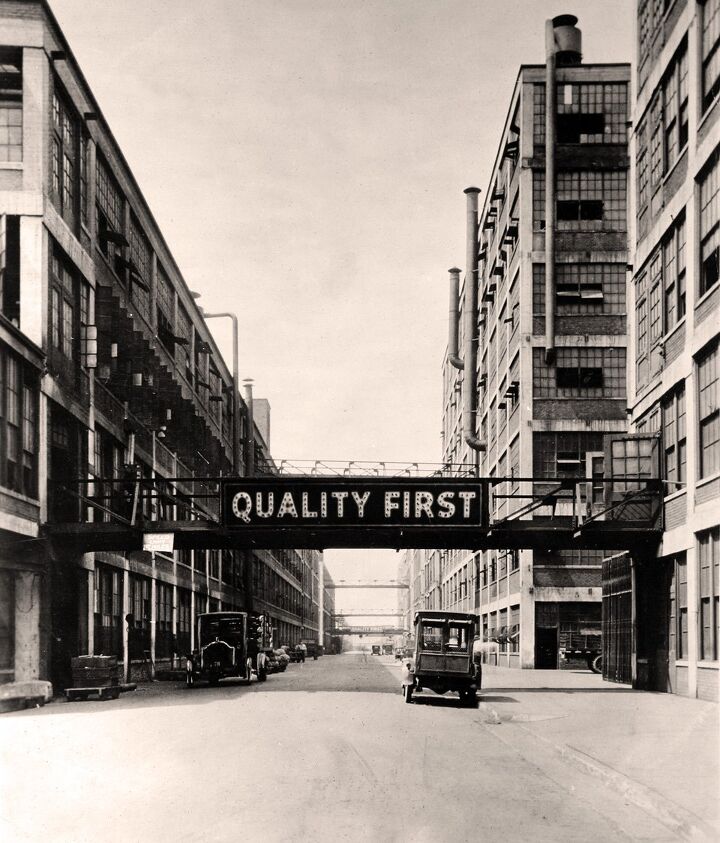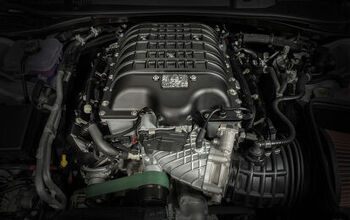So What's the Point? Was Working In A Car Factory Like Being In A Concentration Camp?

Photo: Tom Greenwood/The Detroit News
As Detroiters wait to see if the latest plans to raze the decrepit century old abandoned Packard plant on the city’s east side come to fruition, someone apparently tried to make a point by putting up posters reading Arbeit Macht Frei in the frames of the broken windows of the overpass at Concord Street that connected the two halves of the giant factory. That phrase, German for “work makes you free”, sat above the gates of many Nazi concentration and death camps. Of course that slogan was part of the Nazis’ cruelty because in those camps, the only freedom a prisoner could hope for was the freedom of the grave as they were at best worked to death in labor camps and slave factories, or exterminated in factories of death. The Nazis dangled that carrot, the hope that you could survive if only you worked hard enough, but for eleven million of their victims, more than half of them Jews, that hope was not fulfilled. But in Detroit?
In Dachau
I’m sure that whoever put Arbeit Macht Freiup on the Packard plant thought it was clever, and maybe they were trying to make a point, some grand conceptual or artistic statement, but the only sense that I can make out of it is that the “artists” were too clever by half, or as we Michiganders like to say, stupid. To begin with, the Packard plant is closely associated with Jewish architect Albert Kahn, who designed it.
More to the point, do I really have to say that it trivializes genocide and mass murder to compare it to people freely taking an industrial job to improve their lot in life? Though Packard was not without labor strife in it’s more than half century history, the take I get from automotive history is that Packard employees were exceptionally proud that they produced a world class car, in some ways America’s most prestigious car brand. While the conditions in 1903 when the factory was new were undoubtedly less pleasant than in a modern automotive assembly plant, Kahn’s designs made the factory on East Grand Blvd a nice place to work by the standards of the day, with natural sunlight and ventilation. The old Packard plant was a far cry from a slave labor factory. Remember, the Nazis literally worked people to death. They had guards with machine guns to keep people from escaping. On East Grand Blvd, people lined up for a chance at a job.
Former slogan
People flocked to Detroit, first from around the world, and then from the southern United States, to make a better life for themselves and while they may have resented some aspects of their jobs, or even hated them, I doubt that any would have voluntarily changed places with prisoners in Nazi camps and factories. Those immigrants to Detroit helped create the middle class as we know it. Actually, perhaps that’s the reason for the graffiti. The impulse of épater le bourgeois, skewering the bourgeoisie is not exactly unknown in the art world. The rejection of “middle class values” has driven a lot of modern art and pop culture since the beatniks of the 1950s and maybe even back to American expats in Paris. Maybe the graffiti is trying to tells us that the middle class is a chimera, that industrialization ultimately leads to the Detroit’s famous ruins. Or maybe I’m just thinking too much about a stupid sign.
Ronnie Schreiber edits Cars In Depth, a realistic perspective on cars & car culture and the original 3D car site. If you found this post worthwhile, you can dig deeper at Cars In Depth. If you think 3D is a plot to get you to buy yet another new TV set, don’t worry, all the photo and video players in use at the site have mono options. Thanks for reading – RJS

Ronnie Schreiber edits Cars In Depth, the original 3D car site.
More by Ronnie Schreiber
Latest Car Reviews
Read moreLatest Product Reviews
Read moreRecent Comments
- AMcA My theory is that that when the Big 3 gave away the store to the UAW in the last contract, there was a side deal in which the UAW promised to go after the non-organized transplant plants. Even the UAW understands that if the wage differential gets too high it's gonna kill the golden goose.
- MKizzy Why else does range matter? Because in the EV advocate's dream scenario of a post-ICE future, the average multi-car household will find itself with more EVs in their garages and driveways than places to plug them in or the capacity to charge then all at once without significant electrical upgrades. Unless each vehicle has enough range to allow for multiple days without plugging in, fighting over charging access in multi-EV households will be right up there with finances for causes of domestic strife.
- 28-Cars-Later WSJ blurb in Think or Swim:Workers at Volkswagen's Tennessee factory voted to join the United Auto Workers, marking a historic win for the 89- year-old union that is seeking to expand where it has struggled before, with foreign-owned factories in the South.The vote is a breakthrough for the UAW, whose membership has shrunk by about three-quarters since the 1970s, to less than 400,000 workers last year.UAW leaders have hitched their growth ambitions to organizing nonunion auto factories, many of which are in southern states where the Detroit-based labor group has failed several times and antiunion sentiment abounds."People are ready for change," said Kelcey Smith, 48, who has worked in the VW plant's paint shop for about a year, after leaving his job at an Amazon.com warehouse in town. "We look forward to making history and bringing change throughout the entire South." ...Start the clock on a Chattanooga shutdown.
- 1995 SC Didn't Chrysler actually offer something with a rearward facing seat and a desk with a typewriter back in the 60s?
- The Oracle Happy Trails Tadge




































Comments
Join the conversation
Hope the Packard plant survives long enough for me to see that icon of America's automotive history. I'd love to watch a documentary that shows how the flow of work moved through the complex back in the 20's and 30's. As for the sign, I'd apply Occam's Razor: easiest explanation is that some Occupy moron posted the slogan as an anti-capialist rant.
after reading 'Unbroken' I came to the realization that evil exists in certain cultures. It made clear to me why we dropped the 'bomb'. We in America have our gun culture.... but also freedom of speech and religion...So that some 'bath salt' intellectual can express his/her opinions without fear of going to a 'camp'. I really don't think Detroit is the expression of 'our times' any more than Chicago or Philadelphia.There are just more ruins to post your graffiti on.....